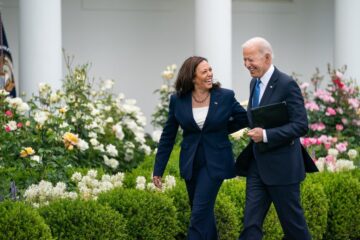Welcome back to Week 47 in my weekly reports analyzing the Covid-19 pandemic and its effects on the country and higher education in the new Biden-Harris administration. For those of you reading this on my blog, Off the Silk Road, I have also launched a newsletter, where these reports can be sent directly to your email each week. Click here to subscribe.
Last week, we showed why the U.S. is at a critical point in the pandemic as a third vaccine was just authorized. This week, we will shed light on the accelerating vaccine rollout as some states take the foolish step of relaxing restrictions.
A national look
Next week marks one year since most of the initial restrictions were imposed at the start of the pandemic in the U.S. A year later, it is clear some states are trying to prolong it. This week, Texas and Mississippi, among a few other states, have rescinded mask mandates, one of the easiest ways to help slow the spread of the virus. Other states have set dates to relax some measures and open up dining to full capacity. In the case of Texas, every time the state has reopened too soon cases have spiked.
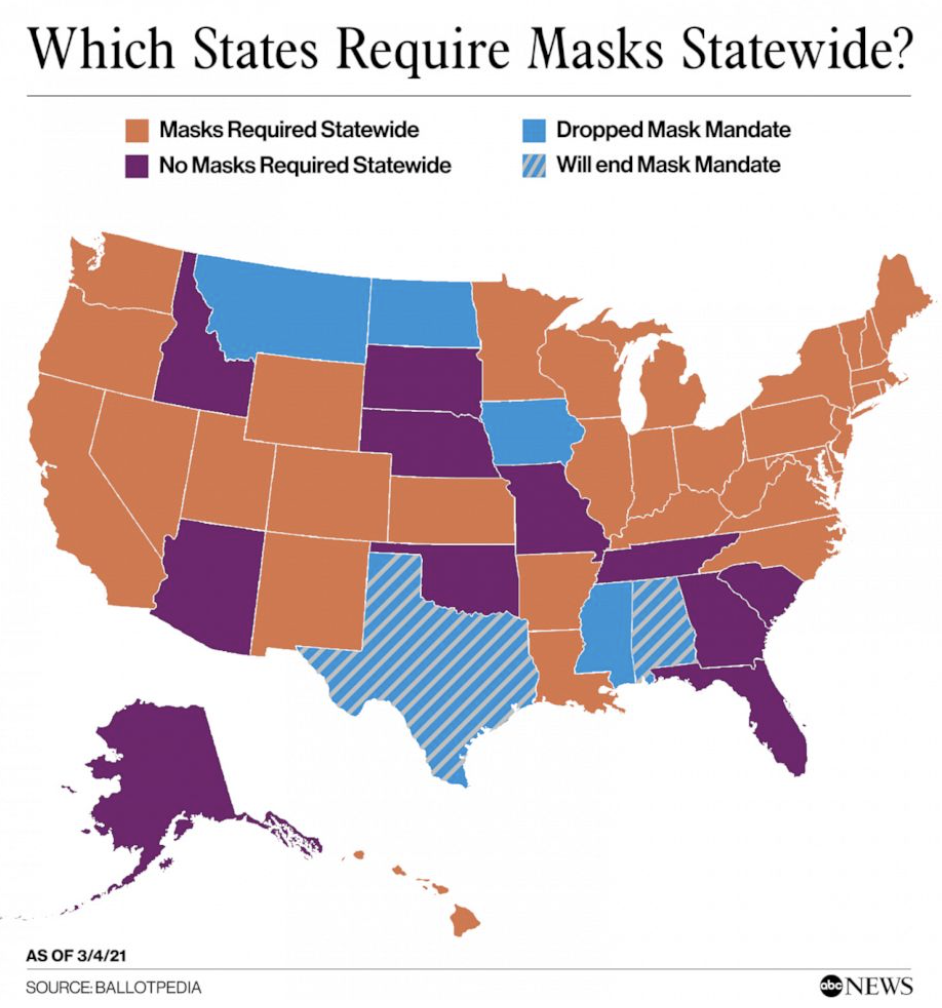
While it is likely that as more Americans are vaccinated, we will be able to relax these restrictions later in the spring and into the summer. However, now is not the time to do so. A recent analysis from lab testing company Helix found that even as cases in the U.S. continue to decline, the B.1.1.7 variant (first discovered in the UK), now constitutes around 20% of new cases in the U.S. In Florida, that number is over 30%.
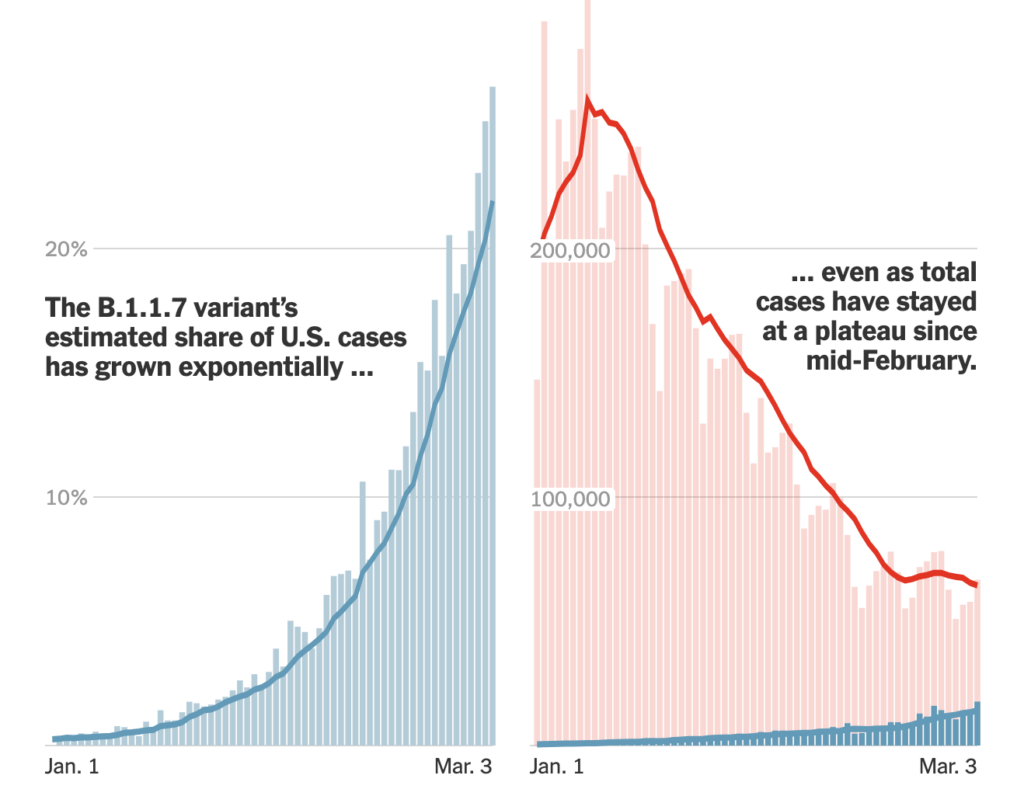
In addition to the B.1.1.7 variant, health officials are also monitoring four other variants, as seen from this White House briefing document.
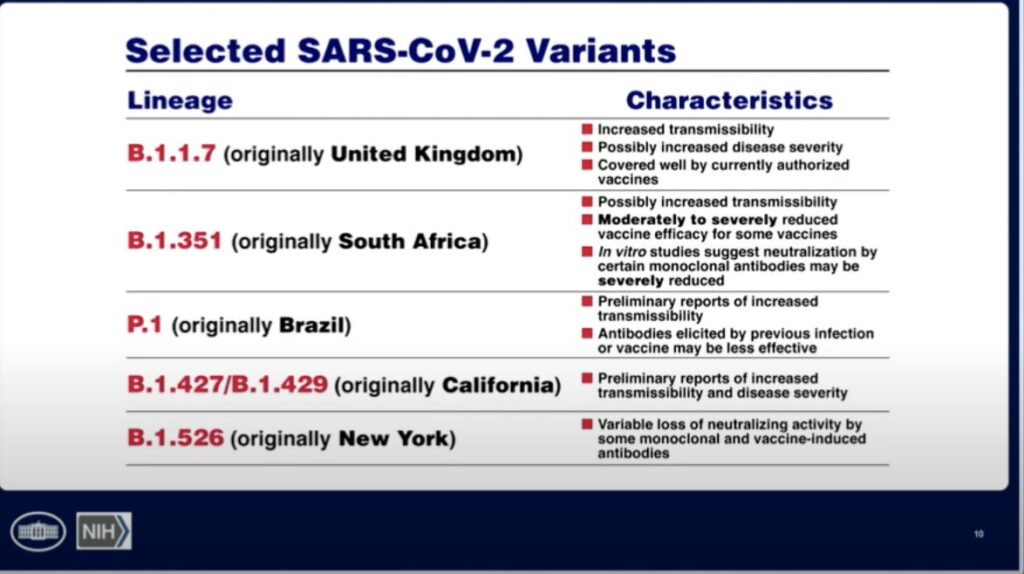
President Biden continues to take aggressive action to combat the pandemic and find new ways to help Americans. Just this week, he announced a historic partnership with Merck and Johnson & Johnson to help manufacture the latter’s vaccine. This means that the U.S. will have enough vaccine supply for every American adult by the end of May (with 100 million Johnson & Johnson doses, as well as 200 million of both Pfizer and Moderna). President Biden would also like all states to vaccinate (with at least one shot) all teachers, childcare workers and school staff by the end of this month. Many states have now continued to prioritize teachers as a result of the White House’s directive. Additionally, the American Rescue Plan was just passed in the Senate and will move to a House vote next week, a critical step to getting aid to millions of Americans.
Let’s take a look at some of the latest scientific developments:
- In the past few weeks, the CDC has dramatically ramped up sequencing of SARS-CoV-2 genomes. Labs have been contracted to help meet the agency’s goal of 7,000 sequences per week. Last week it surpassed it by 5,000 samples.
- The FDA issued an Emergency Use Authorization (EUA) for the Quidel QuickVue At-Home COVID-19 Test, another antigen test where certain individuals can rapidly collect and test their sample at home. The FDA also issued an EUA for a test to detect T cells, which are evidence of past infection — the first test of its kind.
- Work from Yale researchers published in a CDC report demonstrates the stability of saliva in simple plastic containers, illustrating the feasibility of saliva as a collection medium for testing.
- According to a CDC report from a field hospital in New York City last April, the overall infection rate was 1.7%; the rate among those involved in direct patient care was 0.9%. PPE works!
- Brazil is seeing a record number of deaths as the P.1 variant spreads across the country.
- According to data from Danish researchers, the B.1.1.7 variant is now found to increase risk of Covid-19 hospitalization by 64%, compared to other strains.
- On therapeutics: Results from a clinical trial published in JAMA did not support the use of ivermectin for treatment of mild COVID-19. However, an experimental drug in pill form developed by Merck shows early promise in preventing viral replication within the body.
- Scientists in Oregon have spotted a homegrown version of a fast-spreading variant of the coronavirus that first surfaced in Britain — but now it has combined with a mutation that may make the variant less susceptible to vaccines.
- Based on blood samples, CDC researchers estimate that approximately 113,842 (16.3%) of 698,420 young people in Mississippi might have been infected with SARS-CoV-2 by mid-September 2020. However, only 8,993 confirmed and probable Covid-19 cases among young people had been reported to the Mississippi State Department of Health by August 31.
- According to a CDC report, mandating masks was associated with a decrease in daily Covid-19 case and death growth rates within 20 days of implementation. Allowing indoor dining was associated with an increase in daily Covid-19 case growth rates 41–100 days after implementation and an increase in daily death growth rates 61–100 days after implementation. Are you listening, Texas and Mississippi?
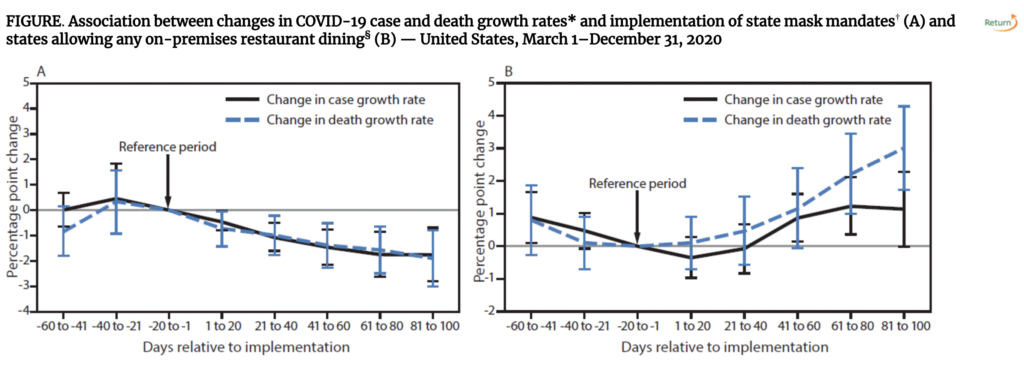
This week, 3.9 million doses of the Johnson & Johnson vaccine were deployed across all states, cities and territories. While some are worried that vaccine hesitancy may turn into “brand hesitancy,” early anecdotal evidence shows that people are eager to get the vaccine due to its advantage of only one shot and its slightly lower side effect profile. This past week saw the highest number of doses from all three manufacturers allocated to states since vaccine rollout began.
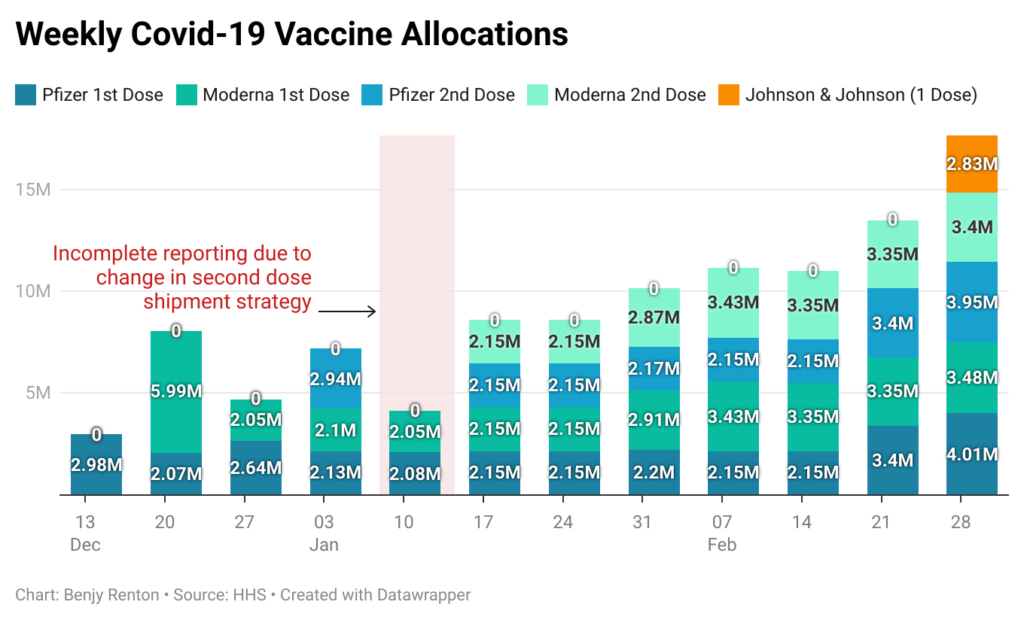
A few other updates on vaccines:
- While some are divided on “vaccine selfie” etiquette, many say it can help boost confidence in the vaccine. “By turning the vaccine from a faceless, scary thing into something dozens of people you know have received, vaccine selfies can open a dialogue and help normalize vaccines as part of everyday life,” journalist Maya Kosoff writes in The Washington Post.
- As the former president took the stage at CPAC and told Americans to get vaccinated for the first time, sources told The New York Times that he and the first lady were vaccinated privately before he left office in January. This comes as a new poll shows that vaccine hesitancy is higher among white Republicans than any other demographic group. The former president had the chance to convince his supporters to take the vaccine and he lost it.
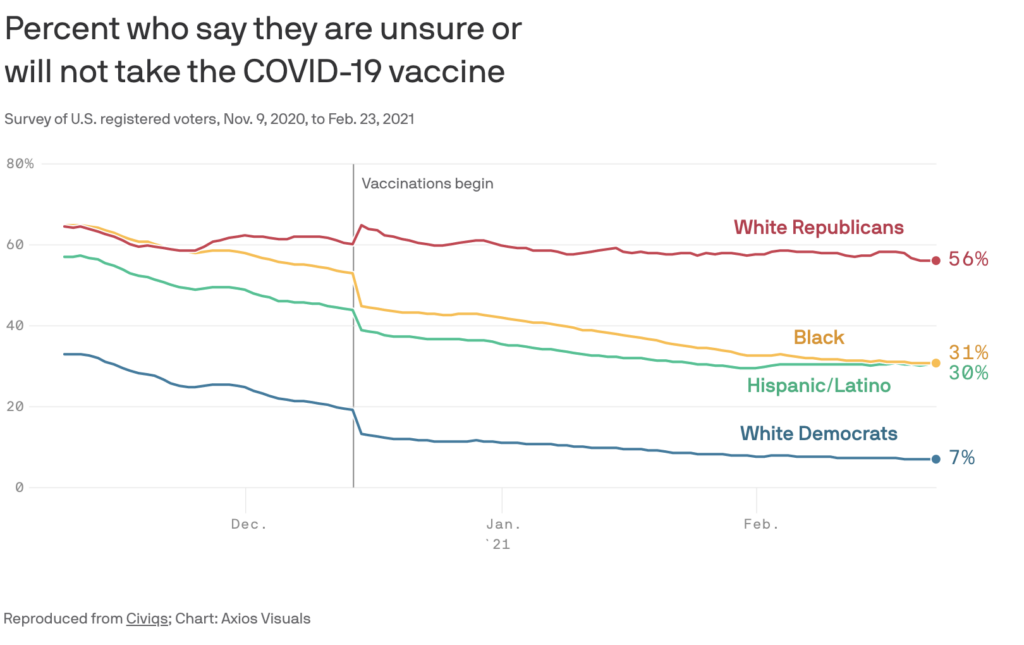
- Modeling published in a preprint on MedRxiv estimates that one dose of the Moderna vaccine reduces the potential for transmission by at least 61%, possibly considerably more.
- Some nations are prioritizing Olympians for vaccinations.
- The Atlantic’s Derek Thompson took a deep dive into the multifaceted issue of vaccine hesitancy.
- LA County officials said that Covid-19 cases among healthcare workers are the lowest they have ever been, illustrating the benefits of vaccination.
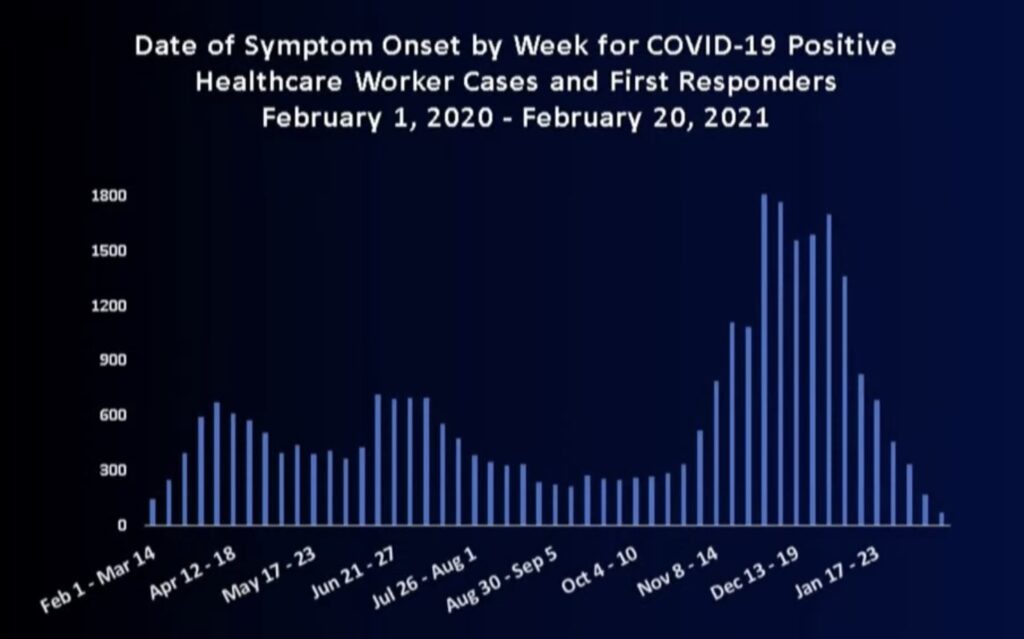
- Gila County, Arizona and Sitka, Alaska, due to their low populations and expedient vaccine rollout, have opened vaccinations to anyone over the age of 18.
- China aims to vaccine 40% of its population before the end of June.
- Italy has blocked export of Oxford-AstraZeneca vaccines to Australia, amid the E.U’s anger at the company’s failure to deliver promised doses to countries within the Union.
- New vaccine data include CanSino’s (China) single-dose vaccine (90% effective) and Bharat Biotech’s (India) vaccine (81% effective).
- “Many are quick to blame “vaccine hesitancy” as the reason, putting the onus on Black Americans to develop better attitudes around vaccination,” Dr. Rhea Boyd writes in The New York Times. “But this hyper-focus on hesitancy implicitly blames Black communities for their undervaccination, and it obscures opportunities to address the primary barrier to Covid-19 vaccination: access.”
- USA Today published an in-depth investigation into Tiberius, the federal government’s vaccine allocation system. Tiberius was released to states in October, and with little training, many states have found the system is too complex and/or contains information they already have. Local health departments know their communities best and most states now only use it to track vaccines.
- According to a study published in JAMA, healthcare workers with previous Covid-19 infection had higher antibody titer responses to a single dose of mRNA vaccine than those who were not previously infected.
- As seen from this analysis published in Kaiser Health News, more than 1.6 million rural residents must travel more than 20 miles to the nearest pharmacy. My vaccination plan from January suggests using fairgrounds and mobile units to reach rural communities.
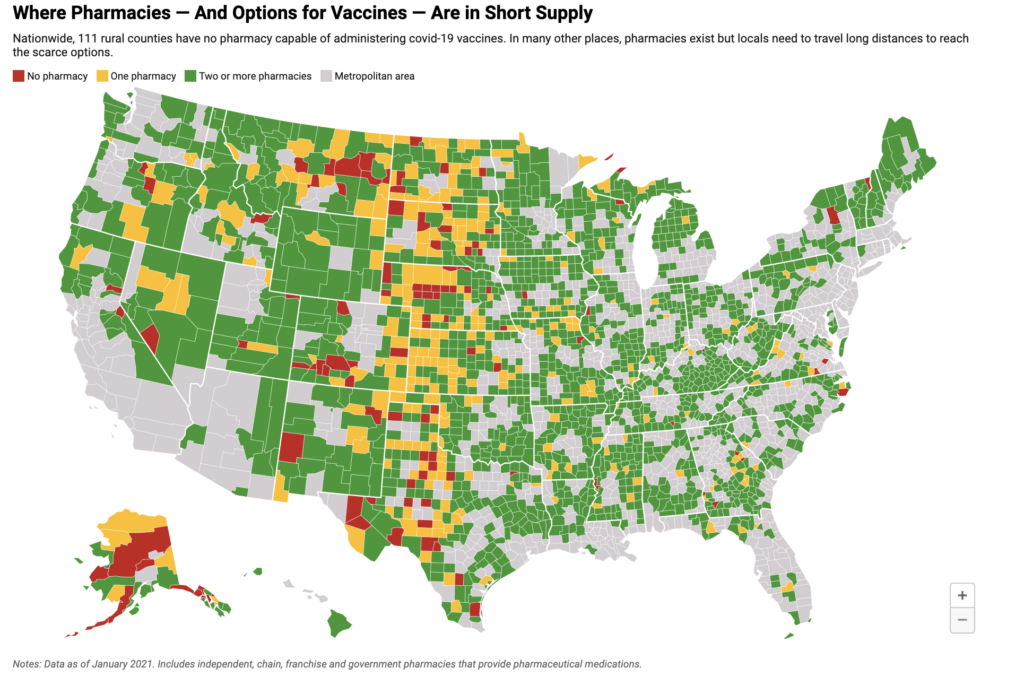
- The CDC is expected to release its guidelines for vaccinated Americans this week.
- The coming years may bring new studies into intranasal vaccines, which could provide an additional degree of protection and help reduce the spread of the virus.
- An investigation from STAT found that in Palm Beach, Covid-19 vaccines intended for rural Black communities are instead going to wealthy white Floridians.
- The New York Times published a helpful explainer on what vaccine efficacy actually means.
- In this week’s Brief19 thread of the week, Yale virologist Dr. Akiko Iwasaki shares her perspective on the theoretical effects of vaccines on Long Covid.
- California announced that 40% of doses will go to 400 low-income zip codes.
- Detroit’s mayor initially declined a shipment of Johnson & Johnson vaccines, saying that other vaccines were “the best” and “Johnson & Johnson is a very good vaccine.”
- According to a Pew poll, 69% of Americans have received a vaccine or intend to get it — up from 60% in November. Democrats are now 27 percentage points more likely than Republicans to say they plan to get vaccinated.
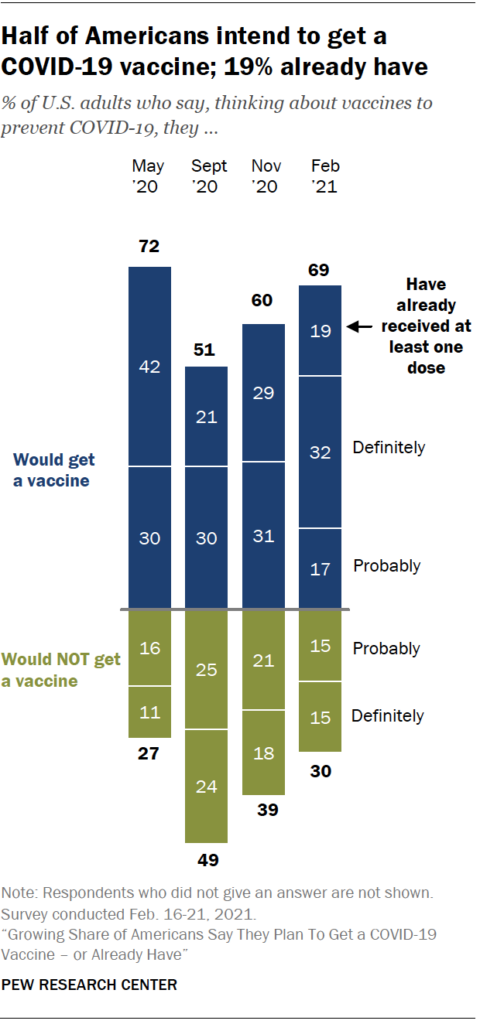
This week marked a significant milestone as the CDC reported the highest day of vaccine administration in the U.S. yet: 2,904,229 were reported on Saturday. This is 20% higher than the previous record. We have a long road ahead of us, but we are well on our way.
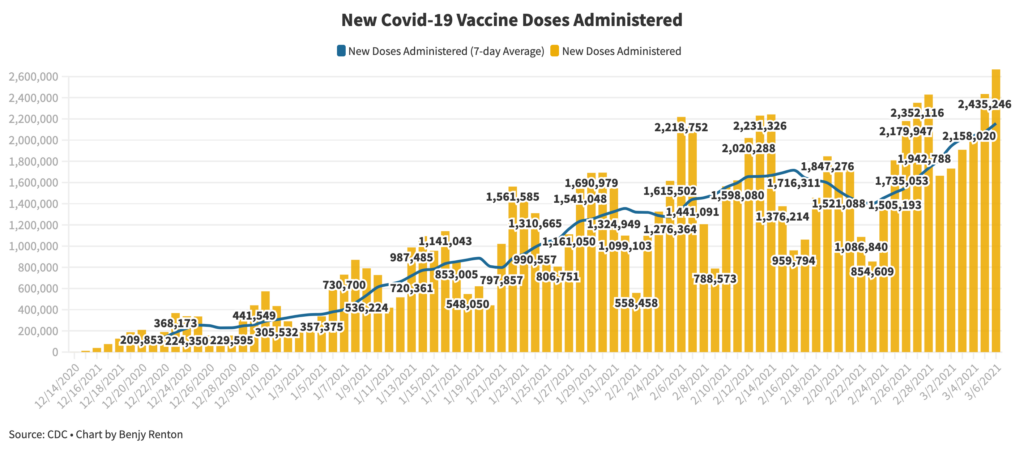
Let’s move on to our discussion of higher education.
Higher education
Here is a roundup of this week’s higher ed news:
- There is an abundance of evidence that testing is a highly effective and affordable way for colleges to detect Covid-19 outbreaks on campus. However, many schools are insistent on using symptom apps and other technology, which have been largely ineffective.
- In order to understand what his students were feeling and the effects of isolation on a campus, Norwich University president Col. Mark C. Anarumo decided to move in with them.
- Bob Jones University, a Christian institution in South Carolina, has backed away from requiring face masks in classrooms.
- While Texas’ governor has rescinded the state’s mask mandate, universities in the state, including the University of Texas, will keep protocols in place.
- According to a survey by the University of Pennsylvania’s student newspaper, undergraduate students are overwhelmingly satisfied with Penn’s Covid-19 testing program but concerned with peer behavior and enforcement of the university’s Covid-19 guidelines.
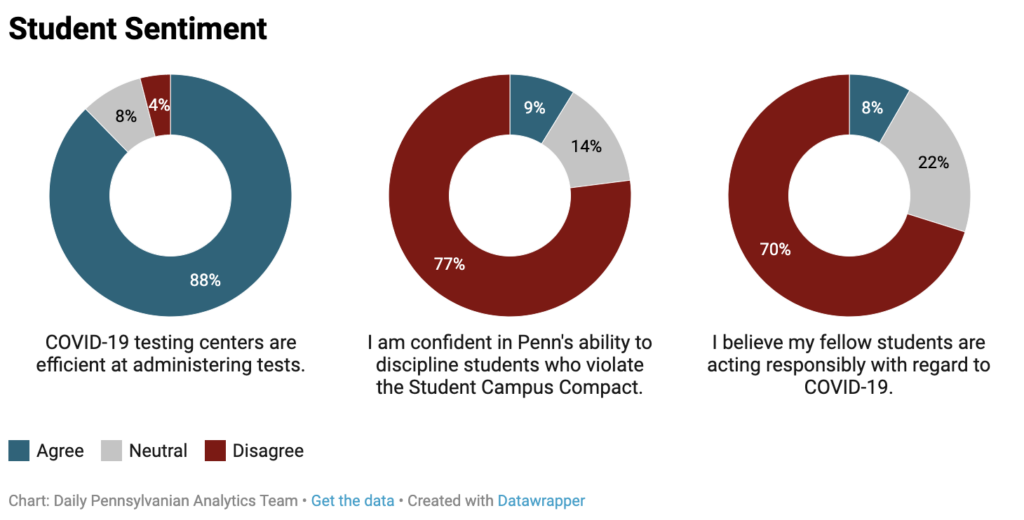
- “No one is invincible, and as I learned at eight, you cannot simply wish away germs,” one Wesleyan student who tested positive for Covid-19 wrote. “Luck is not always going to be on your side. So stack up your cheeses and wear a mask.”
- Almost a year after the school botched its reopening, the University of North Carolina announced its commencement speakers will be Dr. Anthony Fauci and Dr. Kizzmekia Corbett.
- Researchers at Boston University published a paper on the strategies it used to keep its urban campus open this fall, including conducting 500,000 tests, detailed contact tracing data (51% of cases had a source, 55% of the sources were outside BU) and quick tracing (contacts were notified 6.4 hours after the initial positive test, on average).
- Fallout continues after a party of around 100 people in a Williams College dorm last week. 120 students have either left campus or are making arrangements to leave. “The grave mistake of attending a potential superspreader event comes with a responsibility to minimize the harm that could result from it,” the Williams Record editorial board writes. “The College needs to act now.”
- Students at the University of North Carolina once again crowded local streets after the school’s basketball victory last night.
- At Dartmouth College, officials say an outbreak with nearly 200 cases may have been linked to the B.1.1.7 variant, a reason for its fast spread. “The unfortunate reality is that this outbreak and return to lockdown could have been prevented,” The Dartmouth’s editorial board writes. “As a student body, we must remember that our personal actions have ramifications beyond ourselves.”
- A year after the first colleges closed to slow the spread of Covid-19, The Chronicle of Higher Education spent a day in a life on a few college campuses.
- According to research from thousands of student tests at the University of Colorado, at any given time, just 2% of individuals carry 90% of the virions circulating within communities, serving as viral “super-carriers” and possibly also super-spreaders.
- In the first two weeks of the semester, Boston University sequenced 130 genomes and the B.1.1.7 variant was detected in 7 samples (5%). 1 week later 50 more samples were sequenced and B.1.1.7 was detected in 13 (26%).
I remain concerned about the effects of spring break on spread on college campuses, particularly if students travel to Florida. We will wait to see forthcoming evidence this month.
The Good Stuff
Let’s roll the clips of the good stuff. In my usual tradition, I feature my favorite stories from the week. Here are my Top 10.
- This week Dolly Parton received a dose of her own medicine when she received the Moderna vaccine, for which she donated $1 million, singing “Vaccine” to the tune of her song “Jolene.” The doctor who vaccinated her was Dr. Naji Abumrad, whom she met while being treated for an injury from a car accident in 2013. “Honestly, I never had to ask for her support for the research,” Abumrad said, “She’s the one who suggested it.”
Dolly gets a dose of her own medicine. @VUMChealth pic.twitter.com/38kJrDzLqC
— Dolly Parton (@DollyParton) March 2, 2021
- Germans have coined more than 1,200 words to talk about coronavirus.
- I was featured in a BuzzFeed article and a Canadian piece for the story about my Clorox wipes, which I ordered at the start of the pandemic and finally arrived, 349 days later.
- The Golden Globes gave viewers a chance to peek into the homes of stars.
- Star health reporter Chelsea Cirruzzo interviewed other health reporters on how they are documenting the pandemic’s devastating toll and balancing its impacts with their own lives.
- In honor of Black History Month, CNN profiled Black women on the frontlines.
- As some humans have gained weight during extended periods of time at home, some pets have as well.
- Having spent the last few months at the Capitol, New York National Guard member Vincent Scalise now has photos with all 100 Senators.
- After receiving his vaccine, Canadian dancer Gurdeep Pandher danced traditional Punjabi Bhangra outside his wilderness cabin.
- Journalist Rainesford Stauffer wrote about young people reflecting on a pandemic year.
Conclusion
As vaccinations ramp up, the U.S. faces one final hurdle: Variants. This month will be critical to mitigate the effects of various variants on our national trajectory. Now is not the time to relax measures, especially mask mandates. Vaccinations are expected to significantly accelerate in the coming weeks; we just need to get there.
This week we pay tribute to the COVID Tracking Project, whose team members will publish its final data update today. The project has been an invaluable resource through the pandemic, particularly in the early days when federal data was unavailable or hidden. It is through the hard work of hundreds of volunteers that the public was able to be adequately informed. The project will continue in the coming months to produce valuable resources and documentation, including this piece on how to use federal Covid-19 data.
And no, it is never a good idea to burn life-saving masks, as seen here at this “rally” in Idaho.
I’d like to thank all the student journalists with whom I have the pleasure of working. In the next weeks and months ahead, they will become vital in chronicling their colleges’ paths forward for the spring and beyond. Support their work by reading it.
My best to all for good health.
Like what you see? Don’t like what you see? Want to see more of something? Want to see less of something? Let me know in the comments. And don’t forget to subscribe to the weekly newsletter!
For more instant updates, follow me on Twitter @bhrenton.

